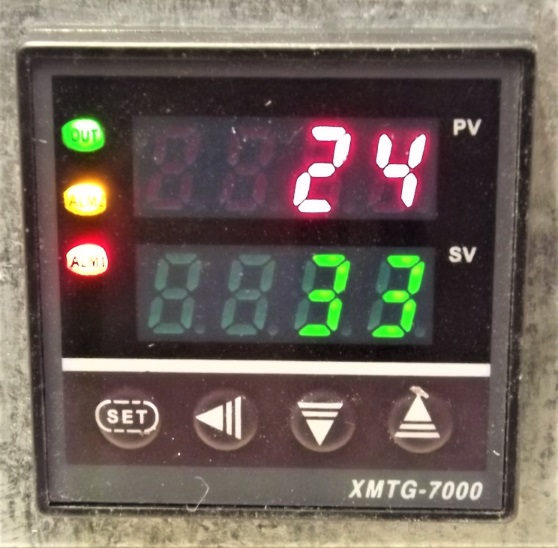- Joined
- Oct 18, 2021
- Messages
- 50
I appreciate that this is an outside shot but I've spoken to the manufacturer and can't quite believe what I'm being told... if any of you use an electric oven I'd appreciate your experience. Here goes.
My oven has an XMTG-7000 PID, and a typical K-type Thermocouple setup.

PV is the Actual Temperature in the chamber, SV is the Target Temperature.
The instructions state that I program a Target Temperature, a time to reach that Temperature, plus a time to hold that Temperature. Simple so far.
However the oven/PID doesn't monitor that the Actual Temperature (PV) has actually been reached! It simply raises the Target Temperature (SV) so that the Target Temperature (SV) reaches the desired value by the end of the heating time period. It assumes that the Actual Temperature (PV) will keep up, (or I guess regulates it to stop it overshooting as it raises the Target temp..)
I ran a quick test.
Heat to 190c in 1 min (impossible, but easy to monitor)
Hold at 190c for 1 min
Off
So what happened? It got to the 190c Target Temperature (SV) and about 100c Actual Temperature (PV) in 1 min.
By the end of the second min the Actual Temperature (SV) had only reached 160c and then it switched off.
Technically it worked since the Target Temperature (PV) of 190c was reached in 1 min, however the Actual Temp (SV) was only ever as high as 160c.
What I expected was it to get to 190c no quicker than 1 min (probably closer to 20mins), but to only start the holding time once the actual temperature had been reached.
This seems backwards to me. A normal basic kitchen oven has a Target Temperature (PV) on the dial and it heats up until the Actual Temperature (SV) meets this (I know it overshoots, but that's another issue)
The manufacturer didn't understand the question. They told me to simply "run multiple tests to check how long it takes to get from room temperature to the actual temperature and then use that time from now on!". He ended up yelling at me that I was asking too much from my kiln and this is how they all work... The manufacturer spoke to me like I was trying to put a man on the moon with a paperclip
This seems ass backwards. I'm basically burning through ££'s of electricity to run multiple tests to figure out how long my oven takes to reach a certain Actual temperature so that I can use that time moving forwards. When I asked how do I calculate a ramp up time from an already hot (eg 400c) oven he couldn't answer other than to suggest that I open the oven and let it drop back down to room temp and start the program over again.
Am I taking crazy pills???
Thanks in advance!!!
Jim
My oven has an XMTG-7000 PID, and a typical K-type Thermocouple setup.

PV is the Actual Temperature in the chamber, SV is the Target Temperature.
The instructions state that I program a Target Temperature, a time to reach that Temperature, plus a time to hold that Temperature. Simple so far.
However the oven/PID doesn't monitor that the Actual Temperature (PV) has actually been reached! It simply raises the Target Temperature (SV) so that the Target Temperature (SV) reaches the desired value by the end of the heating time period. It assumes that the Actual Temperature (PV) will keep up, (or I guess regulates it to stop it overshooting as it raises the Target temp..)
I ran a quick test.
Heat to 190c in 1 min (impossible, but easy to monitor)
Hold at 190c for 1 min
Off
So what happened? It got to the 190c Target Temperature (SV) and about 100c Actual Temperature (PV) in 1 min.
By the end of the second min the Actual Temperature (SV) had only reached 160c and then it switched off.
Technically it worked since the Target Temperature (PV) of 190c was reached in 1 min, however the Actual Temp (SV) was only ever as high as 160c.
What I expected was it to get to 190c no quicker than 1 min (probably closer to 20mins), but to only start the holding time once the actual temperature had been reached.
This seems backwards to me. A normal basic kitchen oven has a Target Temperature (PV) on the dial and it heats up until the Actual Temperature (SV) meets this (I know it overshoots, but that's another issue)
The manufacturer didn't understand the question. They told me to simply "run multiple tests to check how long it takes to get from room temperature to the actual temperature and then use that time from now on!". He ended up yelling at me that I was asking too much from my kiln and this is how they all work... The manufacturer spoke to me like I was trying to put a man on the moon with a paperclip
This seems ass backwards. I'm basically burning through ££'s of electricity to run multiple tests to figure out how long my oven takes to reach a certain Actual temperature so that I can use that time moving forwards. When I asked how do I calculate a ramp up time from an already hot (eg 400c) oven he couldn't answer other than to suggest that I open the oven and let it drop back down to room temp and start the program over again.
Am I taking crazy pills???
Thanks in advance!!!
Jim
Last edited:
